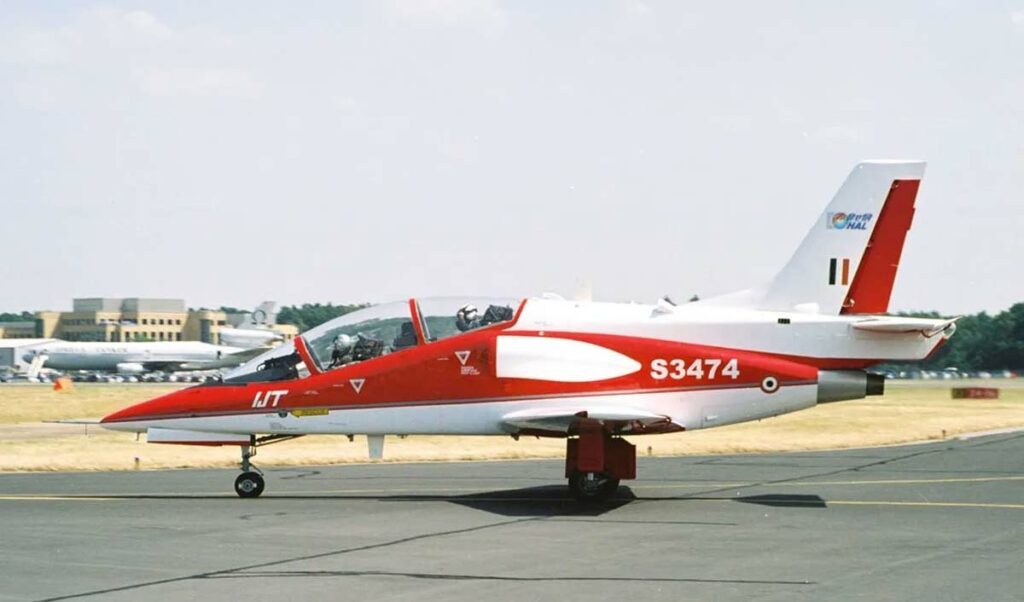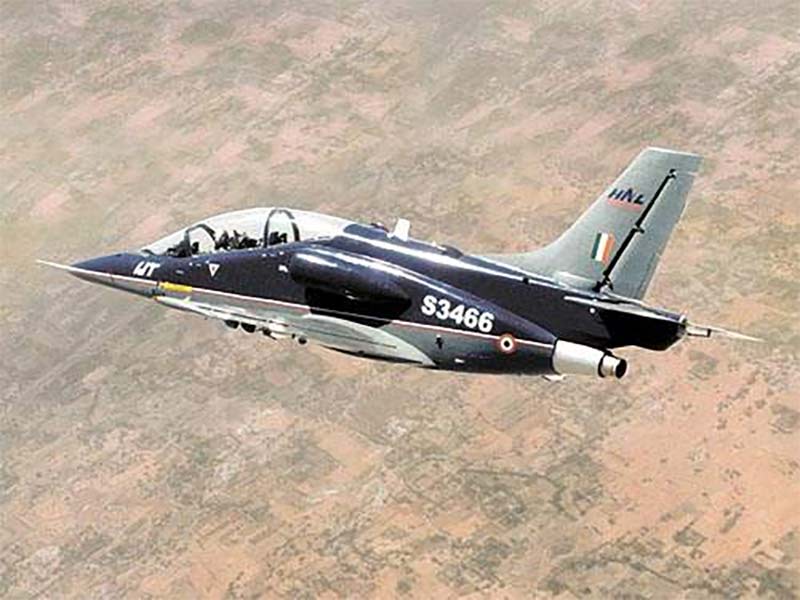The HAL HJT-36 Yashas is a subsonic intermediate jet trainer featuring a low-wing design, tandem seating, and powered by a 17.3 kN NPO Saturn AL-55I turbofan engine.
The HAL HJT-36 Yashas is a subsonic intermediate jet trainer developed by Hindustan Aeronautics Limited (HAL) for the Indian Air Force and Navy. Designed to replace the aging HJT-16 Kiran, it features a low-wing configuration with an 18° leading-edge sweepback and a wingspan of 9.8 meters (32 feet 2 inches). The aircraft is powered by a FADEC-controlled NPO Saturn AL-55I turbofan engine, delivering 17.3 kN (3,900 lbf) of thrust. It boasts a maximum speed of 750 km/h (466 mph), a service ceiling of 9,000 meters (29,500 feet), and a range of 1,000 kilometers (620 miles). The HJT-36 is equipped with a full glass cockpit, integrated digital avionics, and five external hardpoints capable of carrying up to 1,000 kg (2,200 lb) of armaments, including rockets, gun pods, and bombs. Its design emphasizes enhanced pilot visibility and advanced training capabilities, making it suitable for Stage II pilot instruction and light attack roles.
History of the Development of the HAL HJT-36 Yashas
In the late 1990s, the Indian Air Force recognized the need to replace its aging fleet of HJT-16 Kiran aircraft, which had been the backbone of intermediate jet training since their induction in 1968. The Kiran, while reliable, was becoming outdated in the face of evolving aviation technologies and training requirements. To address this, Hindustan Aeronautics Limited (HAL) initiated the design of a new intermediate jet trainer in 1997, aiming to develop an indigenous solution that would meet the modern training needs of the IAF and Indian Navy.
In 1999, following comprehensive reviews by the IAF, the Government of India awarded HAL a contract for the development, testing, and certification of two prototype Intermediate Jet Trainer (IJT) aircraft. The project was sanctioned with an initial budget of ₹180 crore (approximately $40 million USD at the time), with a completion target set for July 2004. The aircraft was christened “Sitara,” meaning “Star” in Hindi, reflecting its intended role as a guiding light in pilot training.
The first prototype, designated PT-1, took to the skies on March 7, 2003, marking a significant milestone in India’s indigenous aircraft development efforts. A second prototype, PT-2, followed with its maiden flight in March 2004. These early flights demonstrated the basic aerodynamic capabilities of the design and provided valuable data for further refinement.
However, the program soon encountered challenges. The initial prototypes were powered by the SNECMA Turbomeca Larzac 04-H-20 non-afterburning turbofan engine, which produced 14.12 kN (3,175 lbf) of thrust. The IAF assessed this powerplant as underpowered for the training syllabus envisaged, necessitating a search for a more suitable engine. In August 2005, HAL entered into an agreement with Russia’s NPO Saturn to replace the Larzac engine with the AL-55I turbofan, offering a higher thrust of 16.9 kN (3,800 lbf). This deal also included provisions for license production of the engine in India, aiming to bolster self-reliance in defense manufacturing.
Despite these efforts, the program faced further delays. The delivery of the AL-55I engines was postponed by two years, with the first engine arriving from Russia on December 28, 2008. Following ground trials, flight testing with the new engine commenced on May 9, 2009. Concurrently, the program suffered setbacks due to accidents involving both prototypes. In February 2007, PT-1 experienced a runway excursion during Aero India, attributed to a canopy locking system failure, resulting in significant structural damage. In February 2009, PT-2 executed a belly landing after a routine aerobatic sortie, causing damage to the undercarriage and wingtip. These incidents necessitated repairs and investigations, further impacting the development timeline.
By 2010, the aircraft had entered limited series production, with initial operational capability anticipated by mid-2011. However, persistent issues, particularly concerning stall and spin characteristics, impeded progress. Spin testing is a critical phase in the certification of trainer aircraft, as it ensures that the platform can safely recover from out-of-control flight conditions—a vital capability for training scenarios. The HJT-36 exhibited unfavorable spin behavior, prompting a comprehensive redesign. HAL collaborated with Bihrle Applied Research Inc., a U.S.-based aviation technology firm, to modify the aircraft’s airframe. The vertical tail was repositioned aft, and the rudder surface area was increased to enhance spin recovery. These modifications required extensive changes to the rear fuselage and were implemented with oversight from certification authorities.
The HAL HJT-36 program encountered multiple technical challenges, particularly with its original powerplant, the locally developed Snecma Larzac 04H20 turbofan engine. The engine’s power output was deemed insufficient for the trainer’s intended flight envelope. To address this issue, HAL later opted for the NPO Saturn AL-55I turbofan, a Russian-developed engine that provided 17.3 kN (3,900 lbf) of thrust, significantly enhancing the aircraft’s performance.
The second prototype, PT-2, first flew in March 2004, incorporating several structural and aerodynamic refinements based on flight test data from PT-1. The aircraft was designed with a low-wing configuration, a tandem cockpit, and a tricycle landing gear system, ensuring improved stability and handling characteristics. By 2005, the program progressed to an extensive flight testing phase, with over 500 sorties conducted by HAL’s test pilots.
In 2007, the aircraft suffered a setback when a prototype experienced a forced landing due to an issue with its airframe structure. Subsequent investigations revealed problems with the tailplane design, prompting a complete redesign. This development caused delays, pushing the certification timeline back by several years. HAL introduced a redesigned tail structure in 2014, which significantly improved stability and control response.
As the aircraft neared certification, additional flight tests continued under close scrutiny from the IAF and India’s Centre for Military Airworthiness and Certification (CEMILAC). By 2019, over 1,500 test flights had been completed, validating the HJT-36’s aerodynamics, powerplant performance, and structural integrity.
The aircraft was officially renamed HJT-36 Yashas in 2022, aligning with India’s strategy to incorporate indigenous nomenclature in its defense programs. Despite prolonged development, the aircraft remains a crucial component of the Indian Air Force’s future training doctrine, with HAL actively working towards its operational induction.

Design of the HAL HJT-36 Yashas
The HJT-36 Yashas features a low-wing monoplane design, optimized for intermediate jet training operations. The 18° swept wings provide a balance between stability and maneuverability, making it suitable for training missions that require precise control input. The aircraft’s airframe is composed of a composite and aluminum alloy structure, ensuring a lightweight yet durable platform.
The cockpit is fully glass-based, equipped with two Multi-Function Displays (MFDs), a head-up display (HUD), and a hands-on-throttle-and-stick (HOTAS) configuration. This setup closely resembles that of frontline fighter aircraft, allowing trainees to transition seamlessly to advanced combat aircraft. The Martin-Baker Mk.16 ejection seats ensure pilot safety, offering zero-zero ejection capability.
The aircraft’s tricycle landing gear is retractable, reducing drag and optimizing aerodynamic efficiency. It features anti-skid braking systems, improving runway performance. Additionally, the twin air intakes positioned beneath the fuselage channel airflow efficiently to the NPO Saturn AL-55I turbofan engine.
While the aircraft’s airframe is aerodynamically efficient, some design drawbacks include lower thrust-to-weight ratio compared to competitors such as the Yak-130 and KAI T-50 Golden Eagle. The Yashas also lacks an afterburner, which limits its acceleration and climb rate when compared to supersonic trainers.
The HJT-36 incorporates five external hardpoints, allowing it to carry up to 1,000 kg (2,200 lb) of payload. This makes it suitable for light attack roles, enabling it to carry rocket pods, unguided bombs, and gun pods. The aircraft is also provisioned for an external fuel tank, extending its operational range when needed.
Performance of the HAL HJT-36 Yashas
The HJT-36 Yashas is powered by the NPO Saturn AL-55I turbofan engine, producing 17.3 kN (3,900 lbf) of thrust. The Full Authority Digital Engine Control (FADEC) system optimizes fuel efficiency and performance across varying flight conditions.
The aircraft achieves a maximum speed of 750 km/h (466 mph), allowing it to perform high-speed maneuvers essential for advanced pilot training. With a service ceiling of 9,000 meters (29,500 feet), the HJT-36 can operate at altitudes suitable for basic air combat training and aerobatics.
The trainer has an operational range of 1,000 km (620 miles) on internal fuel, extendable with external drop tanks. Its rate of climb is approximately 20 m/s (3,937 ft/min), providing sufficient performance for training missions. However, compared to other advanced jet trainers such as the Yak-130 (1,060 km/h) or KAI T-50 (Mach 1.5), the Yashas is relatively slower, positioning it as a subsonic Stage II trainer rather than a high-performance LIFT (Lead-In Fighter Trainer).
The aircraft’s maneuverability is optimized for 6.5G turns, allowing trainees to experience basic combat maneuvering flight regimes. However, it is not equipped with an onboard radar, limiting its potential as a frontline light attack aircraft.

Variants of the HAL HJT-36 Yashas
- HJT-36 PT-1 & PT-2: The initial prototypes, built for aerodynamic and powerplant evaluation. These featured the original Snecma Larzac 04H20 engine before switching to the NPO Saturn AL-55I.
- HJT-36 Yashas Trainer: The production variant, designed for intermediate pilot training. It includes an upgraded avionics suite, improved tailplane, and structural reinforcements.
- HJT-36 Light Attack Version: A proposed variant with upgraded hardpoints, additional weapon systems, and improved survivability features. However, as of 2024, this version remains under development.
Military Use and Combat of the HAL HJT-36 Yashas
The HJT-36 Yashas is primarily designed as an intermediate jet trainer and has not seen direct combat. However, its light attack capability enables it to perform counterinsurgency operations, reconnaissance, and air support missions if required.
The aircraft is capable of carrying:
- 57 mm and 80 mm rocket pods
- 500 lb unguided bombs
- Gun pods (20 mm or 30 mm calibers)
- Practice bombs for training purposes
While the aircraft has not been exported to foreign countries, India has proposed it to Southeast Asian and African nations seeking affordable training solutions. However, competition from China’s L-15 Falcon and Russia’s Yak-130 has limited export success.
As of 2024, the Indian Air Force has yet to finalize large-scale orders for the HJT-36, pending final certification trials. The aircraft is currently being evaluated against other advanced trainers to determine its long-term viability.
Back to the Trainers section.